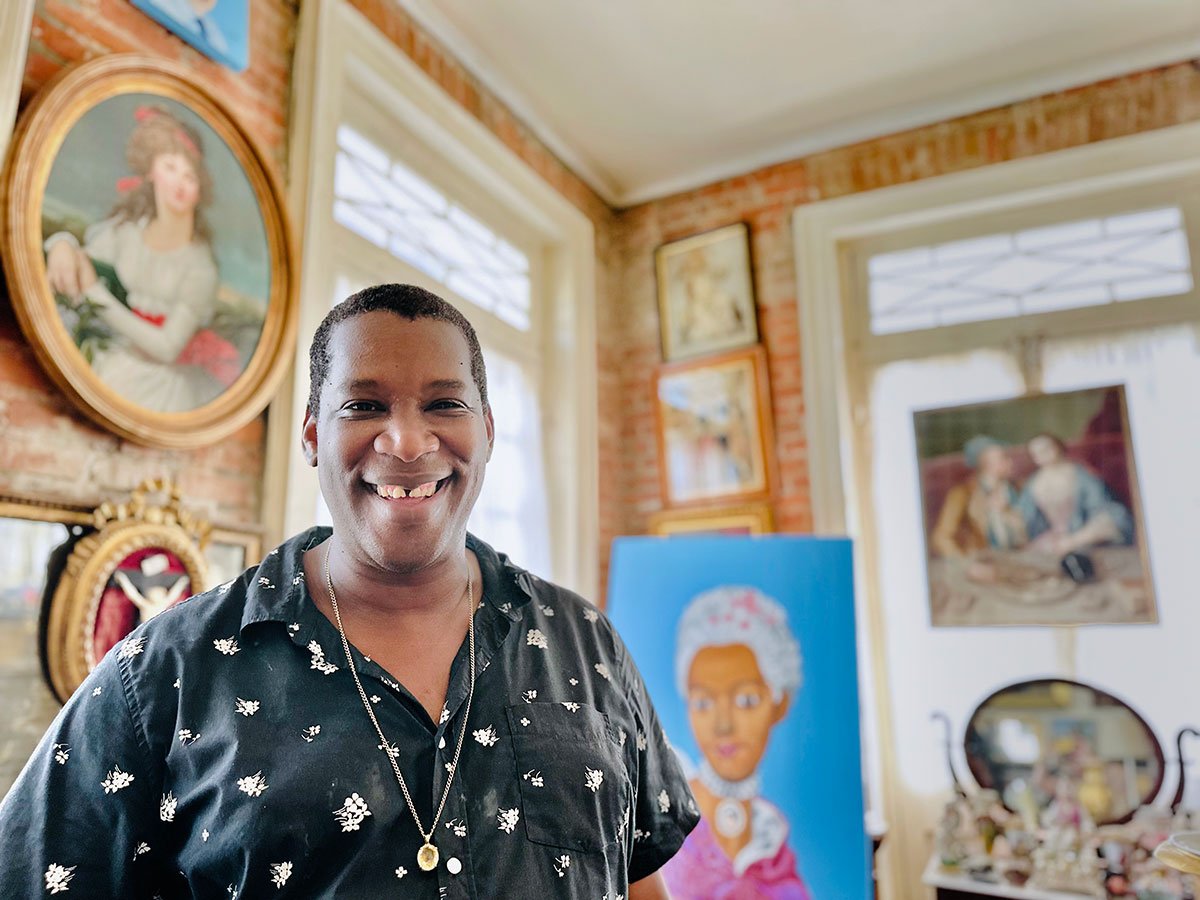A French Quarter Studio Visit: Andrew LaMar Hopkins
Andrew LaMar Hopkins French Quarter studio, July 2023
August 2023As his ten-month show at the Cabildo, “Creole New Orleans, Honey!” comes to a close, the acclaimed artist announces that he’s packing up his lavishly furnished French Quarter studio and moving to Savannah.
– by Saskia Ozols
photos by Ellis Anderson A local art star, Andrew LaMar Hopkins has been profiled in numerous national publications including The Magazine Antiques, the New York Times, and the Wall Street Journal. He has found fame, success, and acceptance in major markets; yet despite frequent travel, Hopkins has always returned to his painting studio in the French Quarter to create and find inspiration.
However that’s going to change soon: a dramatic rent increase on his Barracks Street apartment has precipitated a move to Savannah, where Hopkins has another home and has been spending part of his time. Yet, he hints that it’s not a permanent situation. And it’s difficult to imagine that he’ll be able to move from the city permanently, given the way New Orleans is woven inextricably into most of his paintings.
“Maria LaVeau and Daughters,” by Andrew LaMar Hopkins, 2015
The recent 2022 - 2023 Cabildo exhibit of Andrew Lamar Hopkins’ work “Creole New Orleans, Honey!” weaves together history, fine art, and fantasy [update, March 2024: the show was named Museum Exhibition of the Year by the Louisiana Endowment for the Humanities]. The ten-month Cabildo exhibit highlighted select narratives and imagery of New Orleans, presenting passages through time that extend beyond the boundaries of art, craft, and written history. This museum exhibit includes important New Orleans antiques and paintings displayed alongside Hopkins’ work, creating a space that offers a multi-faceted dialogue between history and contemporary art.
Andrew LaMar Hopkins’ ten-month show at the Cabildo, “New Orleans Creole, Honey!” closes on September 30, 2023.
“Creole Faubourg” by Andrew LaMar Hopkins, 2009
Hopkins’ compositions present the passions of New Orleans through the artist’s use of Caribbean colors in the portrayal of Creole cooking, tropical gardens, and the art of entertaining guests. The use of clear sharp edges and high color contrasts in Hopkins’ vibrant work pulls the viewer into these scenes. Patterns from floor tiles, wallpaper, or carpet are arranged with the same degree of clarity as the figures and situations that occupy the spaces.
That’s apparent in works such as “Creole Elegance,” “The Two Baroness de Pontalba,” and “Desiree & Micaela,” where equal attention to detail is given to every item and interaction. The narrative that unfolds invites contemplation on both situation and environment.
“Creole Brother and Sister,” by Andrew LaMar Hopkins, 2022
“Desirée as Creole Madame Récamier,” by Andrew LaMar Hopkins, 2021
In addition to portraits, interior scenes of Creole life, and garden/cityscapes, Hopkins created a series of work that draws on the art history of Europe. Re-investigating and then painting some of the most well-known paintings in history as “Creole” tableaux offers a strong and contemporary voice.
One example is '“Birth of Creole Venus,” a painting Hopkins called his masterpiece. A re-imagining of Botticelli’s “Birth of Venus,” Hopkins’ interpretation portrays the goddess and all other characters as black or brown, re-creating this famous mythic image and challenging European standards of beauty promoted by art history.
“Birth of Venus” by Andrew LaMar Hopkins
Studio Visit
In late July, we visited Hopkins in the studio he’ll soon be leaving. In a historic building right off of Decatur Street, Hopkins led us through large iron gates, up two flights of hand-crafted wooden stairs straight out of an architectural photograph and into his French Quarter living and studio space.
A new painting nears completion in Andrew LaMar Hopkins’ French Quarter studio, July 2023
Visible from the entrance, a monumental collection of artwork hung salon style, from floor to ceiling throughout. A large George Dureau piece greeted us as we entered through French doors into the kitchen. Hopkins mentioned that he and Dureau were once neighbors (Dureau’s studio was just a few blocks away), and that Dureau’s work inspires him.
Although Hopkins rarely draws or does preliminary sketches, he has a clear admiration for work of the past that is drenched in study, practice and structures of observation. Hopkins is a self-taught artist and sometimes referred to as a “faux naif'‘ painter. His French Quarter studio allowed a new understanding about these relationships and his artistic process.
A few of the many portraits in Hopkin’s antique collection that he began as a youth.
Hopkins’ studio itself is nestled within his art collection, which incorporates antique paintings, prints and drawings. Tables covered in art objects and antique furniture are arranged en masse and create small areas to navigate in the aesthetic journeying toward his painting area. A studio space with windows illuminating his easel from both sides revealed an in-progress portrait alongside a small painting taboret. On top of the paint table sat an array of acrylic paint, strewn brushes, and leftover color mixtures.
The colors stood out from across the room, filled with the darkened varnish of antique pictures hanging wall to wall. His portrait compositions emulate centuries-old standards, yet Hopkins’ backgrounds glow with a contemporary chromatic brilliance.
His dialogue with history extends beyond imaginings of Creole culture and into the well-studied art of Europe. The imagery Hopkins creates addresses contemporary conversations about race, history, culture, gender, gentrification, and survival. New visual conversations occur within his works, ones that go beyond the expected and communicate a vital, yet relatable, point of view.
Hopkins and his alter-ego Desiree will be missed on the New Orleans social scene, and locals collectors will be forced - at least temporarily – to catch his latest works online or visit Savannah. But we, along with the national collector base he has built, will be watching to see how Hopkin’s art continues to evolve.
Join our Readers’ Circle now!















